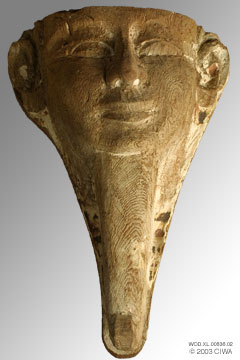
| Period: | | Egypt, New Kingdom, Dynasty 18 |
| Dating: | | 1380 BC–1320 BC |
| Origin: | | Egypt, |
| Material: | | Wood (undetermined) |
| Physical: | | 42cm. (16.4 in.) - |
| Catalog: | | WOD.XL.00636 |
Links to other views:
⇒ Larger View
if scripting is off, click the ⇒ instead.
• • •
Links to others from Dynasty 18
Alabaster unguent jar, Dyn. 18
Alabaster unguent vase, Dyn. 18
Amenhotep III as Amun-Min, Dyn 18
Amulet of Bes, Dyn. 18
Amulet of god Thoth as a Baboon, Dyn. 18
Anthropomorphic mirror handle, Dyn. 18
Basalt shawabti of a king, early Dyn. 18
Blue faience ring, udjat eye, Dyn. 18
Blue faience shawabti, Dyn.18
Bronze Horus sarcophagus, Dyn.18
Bronze insigna-pendant of Atum, Dyn. 18
Bronze of a king as Osiris, Dyn. 18
Bronze of Sakhmet seated, early Dyn. 18
Bronze statuette of Apis, Dyn. 18
Cartonnage of Princess Baket, Dyn. 18
Cartouche ring of Akhenaten, Dyn. 18
Carved face from a sarcophagus, Dyn. 18
Copper inlay for a box, Dyn. 18
Divine scarab, reign of Thutmose IV
Enameled feathers of Amun, Dyn. 18
Extensible bronze bracelet, Dyn. 18
Faience ear ornament, Dyn. 18
Foundation marker from Amenhotep III
Funerary box (panel), Dyn. 18-33
Gilded ib, heart amulet, Dyn.18
Gilded mkrt, snake amulet, Dyn. 18
Gilded ‘tit’ (girdle of Isis) amulet, Dyn. 18
Granite cartouche of Akhenaten, Dyn. 18
Head, realistic portrait in stone, Dyn 18
Horus-the-Child as a ruling king, Dyn. 18
Ibis-headed Thoth with human body, Dyn.18
King Amenhotep II (?) as Amun-Re, Dyn. 18
King Horemheb as a sphinx, Dyn. 18
King Horemheb as Amun-Re, Dyn. 18
King wearing the royal headdress, Dyn. 18
Limestone shawabti, early Dyn. 18
Lotus necklace terminal, Egypt, Dyn. 18
Monumental bronze feather, Dyn. 18
Mummy mask of a young woman, Dyn. 18
Nekhbet, vulture-goddess of Nekheb
New Year’s flask for sacred water, Dyn.18
Osiris, King of the Afterlife, Dyn. 18
Osiris of an unknown king, Dyn. 18 (?)
Osiris-Neper, god of agriculture, Dyn. 18
Pair of udjat eyes of Horus, Dyn. 18
Palm leaf amulet, Dyn. 18-19
Palm leaf amulet, Dyn. 18-19
Pillar capital, Hathor, Dyn. 18
Polychrome glass cup, Dyn 18
Queen as Goddess Mut, Dyn.18
Queen Hatshepsut as Goddess Mut, Dyn. 18
Queen Hatshepsut as Hathor, Dyn. 18
Queen Isis as Isis nursing Thutmose III
Royal situla, sacred water vessel, Dyn.18
Royal wooden sarcophagus lid, Dyn. 18
Sakhmet amulet pendant, Dyn. 18
Sarcophagus of a king, Dyn. 18
Sarcophagus of a queen, Dyn. 18
Scarab “begets the existence of Amun”
Scarab of protection, Dyn. 18
Scarab of Thutmose III, Dyn. 18
Scarab of Thutmose III, Dyn. 18
Scarab of Thutmose III, Dyn. 18
Scarab of Thutmose III, Dyn. 18
Scarab of Thutmose III, Dyn. 18
Scarab of Thutmose III, Dyn. 18
Scarab of Thutmose III, Dyn. 18
Scarab of Thutmose III, Dyn. 18
Scarab of Thutmose III, Dyn. 18
Scarab of Thutmose III, Dyn. 18
Scarab with Amun-Re, solar discs, Dyn. 18
Scarab with ‘Ba’, Dyn. 18
Scarab with “faith in Justice,” Dyn. 18
Scarab with Goddess Hathor
Scarab with Horus of the Horizon, Dyn. 18
Scarab with ‘nsw-bity’, Dyn. 18
Scarab with ‘sa’ singing birds, Dyn. 18
Shawabti of Amen, vizier of Amenhotep III
Shawabti of Queen Mutemwia. Dyn.18
Signet-ring of Tutankhamun, Dyn. 18
Statuette of a privileged man, Dyn. 18
Stone bust of a scribe, Dyn. 18
Stone shawabti of a Nubian viceroy, Dyn. 18
Stone statue of King Thutmose III, Dyn. 18
Two cobras from the queen’s crown
Udjat eye amulet-pendant, Dyn. 18
Uninscribed wooden shawabti, Dyn. 18
Uraeus from a royal crown, Dyn. 18
Wood statue of King Smenkhkare, Dyn. 18
Wooden sarcophagus lid, Dyn. 18
Wooden sarcophagus lid, Dyn.18
Wooden sarcophagus lid, Dyn. 18
Links to others of type Coffin/sarcophagus lid
Face from a sarcophagus lid, Dyn. 26
Head of a sarcophagus lid, 590-350 BC
Royal wooden sarcophagus lid, Dyn. 18
Sarcophagus of a king, Dyn. 18
Sarcophagus of a queen, Dyn. 18
Wooden sarcophagus lid, circa 650 BC
Wooden sarcophagus lid, Dyn. 18
Wooden sarcophagus lid, Dyn.18
Wooden sarcophagus lid, Dyn. 18
|
|
This wooden face carving is all that is left of the sarcophagus lid it once set off. Scattered remains of gesso and paint reveal that this was once a finished work, and not a study. The rough chiseling over the eyes suggests they were not merely gessoed, but inlaid, and framed with extensive makeup.
Although the finish is gone, and the absence of the headdress makes for less than harmonious proportions, the excellence of the modeling still shines through. The elegance and the type of smile (which differs from the smile of the Saite Dynasty), suggest that this was crafted in the artistic heyday of the New Kingdom, probably in the last third of Dynasty 18 (1380-1320 BC).
Sarcophagus
Sarcophagus is a Greek term used in Egyptology to designate a container made to protect a mummified body (the term literally means “body eater”). Although we are guilty here of using the term loosely, the generally accepted convention today is to use ‘sarcophagus’ for a stone container, and ‘coffin’ for a wooden or metal container.
Initially, Egyptian coffins were rectangular (sometimes with arched tops). They were decorated with symbolically charged motifs and ritual texts. Around Dynasty 12 (Middle Kingdom) appeared the first anthropomorphic coffins, which followed the general shape of the human body. By the New Kingdom, royal burial sets had become very elaborate: “The mummy. . . lay in three mummiform coffins; the innermost is made of solid gold, and the other two of wood covered with sheet gold. . . [the] set of anthropomorphic coffins was laid into a rectangular or cartouche-shaped sarcophagus, which in turn was surrounded by several chapel-like wooden structures. . .” (Redford 2001:[1]283).
Bibliography (on Sarcophagus)
Redford, Donald B.
2001 Oxford Encyclopedia of Ancient Egypt. Oxford University Press, London. (283)
|